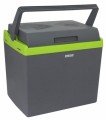Volume
The volume of the working chamber of the car refrigerator. The larger the volume, the more products can be loaded into the unit at a time. When choosing according to this parameter, it makes sense to select a model with a margin, because it is not recommended to load products too tightly — this adversely affects the quality of the device. On the other hand, note that the volumetric container and dimensions will have the appropriate ones.
Number of chambers
The presence in the refrigerator of separate zones for storing products, separated by a stationary dense wall of a non-removable structure. The vast majority of car refrigerators have a
single-chamber layout, however, there are also
two-chamber models, which is extremely convenient for sorting products.
Max. cooling at
This parameter determines how many degrees the refrigerator is able to cool the product loaded into it relative to the ambient temperature. Let's say the maximum cooling for a particular refrigerator model is 20°C; at an air temperature of +30°C, a product with the same temperature is loaded into it. Thus, the final temperature of the product will be 30 – 20 = +10 °C. In addition, it should be noted that the final temperature cannot be lower than the minimum cooling temperature (see Minimum cooling temperature)
Max. heating at
An indicator of how many degrees the refrigerator is able to heat the product placed in it relative to the ambient temperature (if there is a heating function). Suppose a product at a temperature of +15 °C is placed in a refrigerator with a maximum heating of 60 °C; thus, the temperature of the product at the end of heating will be 75 °C, which is more than enough for the perception of food as warm and its comfortable consumption.
Min. cooling temperature
The minimum temperature to which the refrigerator is able to cool the product placed in it when operating in cooling mode. It should be taken into account that the minimum cooling temperature is not always achievable in fact: the actual cooling temperature depends on the ambient temperature and on the capacity of the refrigerator for maximum cooling (for more details on the calculation formula, see "Maximum cooling per (°C)"). However, this applies only to refrigerators that are not equipped with compressors (see Compressor);
compressor models are able to reach the minimum cooling temperature regardless of external conditions.
Сooling energy consumption
The power consumed by the refrigerator when operating in cooling mode. The greater this power, the more performant the refrigerator is, usually, and the less time it takes to cool the product. On the other hand, note that more power means more power consumption — which can be critical, for example, during long-term operation from a car battery (that is, when the car engine is turned off).
Heating energy consumption
The power consumed by the refrigerator when operating in heating mode. As with cooling, more power usually means more performance; see "'Сooling energy consumption" for details.

